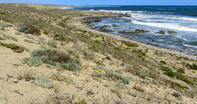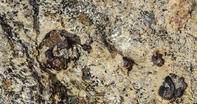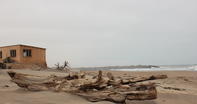Diamond Oysters
In 1926, the famous German geologist Hans Merensky hurried up to Namaqualand. He had a theory that the diamonds were linked to fossilised oyster beds on old marine terraces.

He quickly formed a syndicate with Dr Ernst Reuning, Dr I.B. Celliers and J.J. Buschau to search for this ‘oyster line’. Now, things were really hotting up and deals were being brokered at a feverish pace. Accordingly, a police sergeant, Van Wyk, sold his claim to Caplan for 15 pounds. Caplan then gave Merensky permission to inspect upper levels of this claim, unaware of the ‘oyster line’ theory.
Rising Stakes

While this was going on, Reuning offered to buy the claim from Caplan and a price of £17 500 was agreed on. Almost immediately, a 16.5 carat octahedron was found. With Caplan kicking himself, Hans Merensky scrambled to find the money to pay for the claim before the offer expired.
A deal was subsequently made with H.O. Althauer and Julius Jeppe to form Hans Merensky Associates, with Merensky getting 50% of the company and the other two backers getting 25% each. Merensky’s previous partners were thus pushed out of the deal and Reuning only got a token £150 pounds per month plus a bonus of £5000 pounds if the claim was successful.
With the stakes rising, Merensky optimistically applied to the Minister of Mines for a mineral lease over all public lands in the area, but this was refused. Instead, the government stopped the prospecting on crown lands and transferred all mineral rights to the crown. The only exception to this was the private farm Kleinzee, which was offered to the government for £200.
Inexplicably, this sale was turned down and Kleinzee was sold to the Cape Coast Exploration Company (CCEC). This company was soon bought up by De Beers – which still operates the Kleinzee mine to this day. Visits to the mine can be arranged, but must be booked at least 5 days in advance.
Frozen Diamonds

In the face of this government clampdown, Merensky’s HM Associates fought to have their original claim recognised. This was accomplished and Merensky also managed to get another 5 claims honoured by the Department of Mines. The first shipment of diamonds from the Hans Merensky Associates claims totalled 12 253.5 carats. Ernest Oppenheimer immediately bought a 74% interest in Hans Merensky Associates.
Then, in 1927, the Precious Stone Bill was passed, which empowered the state to establish a State Alluvial Diggings around Alexander Bay. This developed into the company known today as Alexcor. The Bill also allowed for the government to monitor and control the output of all diamond producers.
This was bad news for HM Associates who, by now, had recovered 461 393 carats. Fearing an oversupply of diamonds, the government froze the sale of these diamonds. In 1929, Merensky sold his company to Oppenheimer for £3 million and went into voluntary liquidation. In 1932, the Merensky diamonds are ceded to the Diamond Corporation, a newly established central selling organisation which sought to control the sale of all diamonds to prevent oversupply.
Finally, in 1937, the Merensky diamonds were released for sale in London and at the New York World Fair of 1939. A final sale took place in 1942 in Bermuda.
By David Fleminger